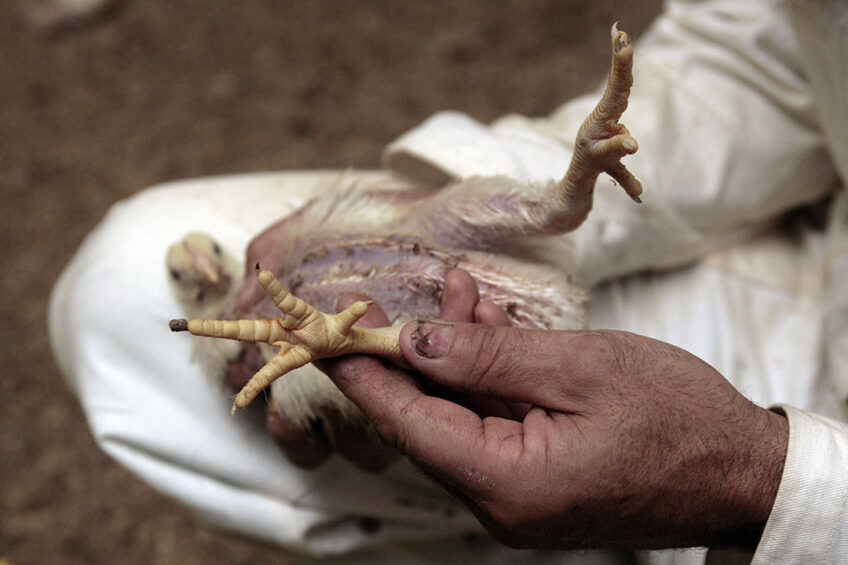Organic minerals promote broiler leg quality

In broilers, leg problems can lead to reduced health and animal welfare, but also to higher mortality and lower processing yields. Preventing leg problems is therefore of great importance for both the bird and the broiler farmer.
One factor that plays a major role in the development of the leg bones, and thus the outlook for the prevention of leg problems in later life, is nutrition. Minerals, in particular, play an important role in the formation of bones.
Because broilers have a rapid growth rate and are slaughtered at a relatively young age, it is important that the tibia bone develops quickly. Therefore, the availability of minerals from the diet also needs to be high. Mineral sources can be divided into macro minerals (calcium and phosphorus) and trace elements (e.g., iron, copper, zinc, manganese and selenium). All these minerals come from natural sources, usually in the form of salts. These are called inorganic minerals and are included in most broiler diets.
Research shows fly larvae can improve leg health
A recent study at Wageningen University and Research used live black soldier fly larvae as an environmental enrichment tool. Read more…
Organic minerals
However, minerals can also be attached to a protein or amino acid and are then called organic minerals. Organic minerals are absorbed faster and better in the broiler gut than inorganic minerals. This ensures greater mineral availability and could potentially lead to better bone development and fewer leg problems. However, it is not known whether this is the case or whether the use of organic macro minerals has the same effect on bone development as the use of organic trace elements. Wageningen University and Research looked into this matter in an experiment financed by the Dutch Ministry of Agriculture, Nature and Food Quality, Aviagen, Darling Ingredients, ForFarmers, Hubbard, Marel Stork Poultry, Nepluvi and Nutreco.
Experiment with male chicks
Eggs from Ross 308 parent stock, weighing between 61 and 65 grammes, were incubated at the experimental facility of Wageningen University and Research. After hatch, 864 male chicks were transported to the research facility of ForFarmers in Nijkerk. The chicks were divided into 72 pens with 12 chicks per pen. The pens were 0.90 m2 and the chicks had access to wood shavings as bedding material. The house temperature started off at 32°C and was reduced to 22°C on day 42. The chicks were given continuous light for the first 3 days and then received 16 hours of light and 8 hours of darkness per day. The chicks received an IB vaccination on the day of arrival and an NCD vaccination on day 11.
Diets with macro minerals and trace elements
All the diets were identical except for the type of macro minerals (calcium and phosphorus) and trace elements (iron, copper, zinc, manganese and selenium). The chicks in the 72 pens were divided over 4 dietary treatments so that the effect of inorganic and organic raw materials could be examined for both macro minerals and trace elements. These regimes were:
- Inorganic macro minerals and inorganic trace elements.
- Inorganic macro minerals and organic trace elements.
- Organic macro minerals and inorganic trace elements.
- Organic macro minerals and organic trace elements.
A 3-phase feeding system was used (days 0-10, 11-28 and 28-42) and the 4 treatments were applied in each feeding phase. Chicks were fed ad lib and also had unlimited water available.
Higher phosphate level better for poultry bone formation
Recent research shows that it is not the calcium, but the phosphate level that has a strong correlation with bone formation. Read more…
Measurements
Birds were weighed at placement and on days 10, 21, 27, 34 and 42. Feed intake was also measured on the same days so that feed conversion could be calculated. Mortality was recorded every day.
On day 42, 2 chicks per pen were scored for footpad lesions. These chicks were then sacrificed for necropsy and the left leg was scored for abnormalities (bacterial chondronecrosis with osteomyelitis, epiphyseal growth plate abnormalities, epiphysiolysis and footpad lesions). The tibia was removed from the right leg and its length, thickness, volume, mineral content and mineral density were determined (Figure 1). How much force was needed to break these bones was then measured.

Results
At day 42, the birds that were fed organic macro minerals and also received organic trace elements showed a higher body weight compared to the inorganic variants (Table 1). In addition, the feed conversion over the total growth period was 5 points lower in the group of organic macro minerals and 6 points lower in the organic trace elements group. Mortality did not differ between treatments.
The percentage of chicks with leg abnormalities at day 42 slaughter was very small (<1%) and did not differ between treatments. the quality of the tibia bone was not influenced by the type of trace elements. however, the chicks fed organic macro minerals (calcium and phosphorus) had longer and larger tibia bones with more minerals and it also took more force to break these bones (>Table 1).
Positive effects
Based on this study, it can be concluded that the addition of organic macro minerals and trace elements has a positive effect on the growth and feed conversion of broilers. However, the calcium and phosphorus source, in particular, also appears to be important for leg bone development, with organic calcium and phosphorus resulting in better development and stronger bones. With better bone development, the bird may be able to bear the rapidly increasing weight more easily, resulting in fewer leg problems. The latter could not be demonstrated in this study, but this might be the case at a higher stocking density under commercial rearing conditions.
By Henry van den Brand, Bahadir Can Güz, Roos Molenaar, Ingrid de Jong, Wageningen University and Research












